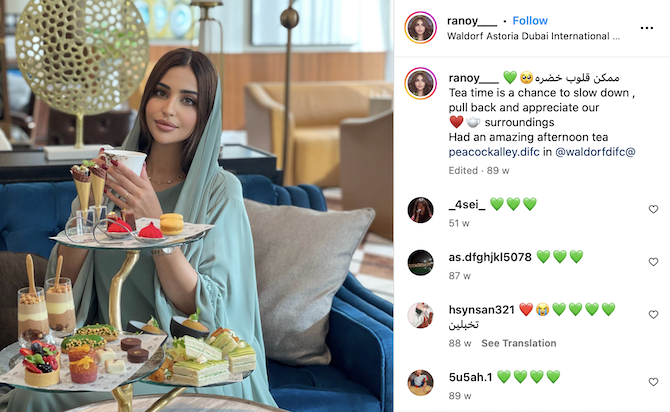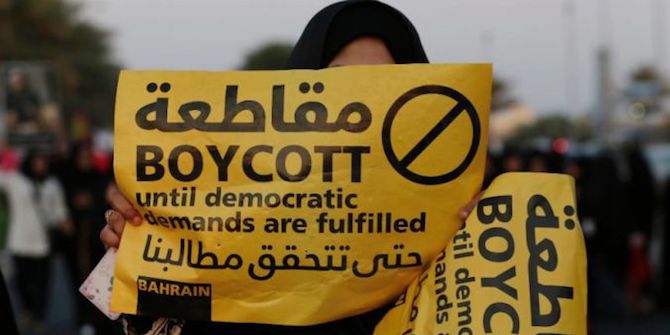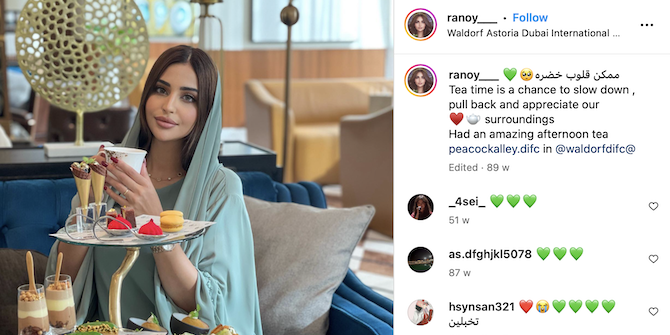by Zoe Hurley

Gulf Arab women influencers, known as microcelebrities, gain impetus from social media’s visible economy. Popular microcelebrities include Saudi Arabian rapper @Amyroko, who wears a facial covering, or niqab, while advocating women’s rights. @Ranoy_ is an Emirati creator of scary stories on YouTube. Kuwaiti beauty blogger, model, and modest fashion designer – @ascia, promotes third space female Muslim identity as a non-hijabi.
These influential public figures are representative of the Gulf’s shifting popular cultures and debates around women’s empowerment. But although Gulf Arab women are prolific social media users, Gulf postfeminist subjectification represents a gap in feminist scholarship. Subjectification refers to the ways a subject observes, presents and promotes themself, often as a product or self-brand. Post-feminism is a sensibility which repackages women’s supposed goal to please men into the desire to please one’s self. Taken collectively, postfeminist subjectification manifests as a resignation to the neoliberal logics of the market. However, its ramifications are not uniform, and we need to understand more about Gulf Arab women’s subjectification.
To address this issue, we can explore the case of women’s microcelebrity within the location of Khaleej culture. Khaleeji (male) or Khaleejiyah (female) is a person from one of the Gulf Cooperation Council (GCC) states, Saudi Arabia, Bahrain, Kuwait, United Arab Emirates, Qatar and Oman. Khaleej visual cultures, while not entirely homogenous, are underpinned by postcolonial nationalism, Islamic values and dialectics of neoliberalism. Modest fashion and hijabi politics, including discussions of what women should and should not wear, are hot topics indicating the role of Khaleejiyah microcelebrities as bearers of postcolonial identity. But Gulf female historiography tends to be crudely polarised between Orientalist and anti-Orientalist approaches and, while Orientalism essentialises Islam and ignores its variations, anti-Orientalism marginalises Islamic ontologies.
To counter oblique perspectives, the three-step approach of this study takes into account the observable elements of the images, the objects of meaning and the contextual interpretations. This analysis allows for a better understanding of the Khaleejiyah visibilities while revealing the paradoxes of Gulf states who are, in several respects, themselves acting like influencers.
Dubai, for instance, is the Emirates’ best known glitzy cityscape, defined by startling architecture. Qatar is renowned for prestige sporting events. Saudi Arabia, as the cradle of Islam, is promoting alluring cultural heritage sites, like Al-‘Ula, located on the historic incense route linking India and the Gulf to the Levant and Europe. The Gulf states’ curations of visual capital suggest that its financial sustainability depends partly on attracting eye-balls in the visible economy. But, like Khaleejiyah microcelebrities, Gulf subjectification hangs in the balance of tradition, reputation and honour. Although Gulf nations might once have deflected western opinion, they are currently seeking luminosity on the global stage. Similarly, Khalijiyah communities were previously enshrouded within the gendered domestic sphere but are now expanding digital visibilities to remain financially buoyant.
To consider these ambivalences, we can analyse the Instagram post above to reveal the ideologies encapsulating @Ranoy_’s image. Observable elements include @Ranoy_ enjoying a high-tea at Dubai’s Waldorf Astoria Hotel. Her teal-green robes crown her glossy hair and are an update on the traditional Kaleejiyah black abaya and hijab. Wearing a serene expression, head slightly tilted and hands around a cup, to a European-eye, she might appear like an icon from a Renaissance painting. But Renaissance muses tended to cast their eyes down demurely while @Ranoy_ gazes directly out, striking the pose of central protagonist, and invites parasocial engagement with viewers. In terms of contextual interpretations, the image sits within the modest fashion space and distinctly modern Khaleejiyah sensibility. The portrait is a metonym for Dubai’s sophistication as premier consumerist city and coming of age in the time of social media. Simultaneously, it operates within the dialectical realm of Khaleej modernity and pillars of patriarchy that Khaleejiyah patronage rests upon.
We can also reflect on how modalities of colour, framing and subject-positioning tacitly embed regimes of power. @Ranoy_’s bright outfit suggests fresh Khalijiyah sensibilities, much like the elegant pastries displayed on the tea-tray. But the sweet desserts and @Ranoy_’s portrait are both visual props and a type of modest ‘thirst-trap’. Although they might be visually available, they are to be admired from a distance and represent a banality that Walter Benjamin called a ‘commodification of things’. This distracts from underlying economic relations since an image’s framing consists of what can be seen as well as what is obscured. Instagram blurs the line between amateur and professional photography and digital labour occurring behind the scenes is invisible. The image retains the fourth-wall of fiction, concealing choreography, social relations and production. But beneath the veneer of realism, there is an entire industry of platform capitalism, product endorsements, domestic, service and migrant hospitality workers, who prepare, serve and clean the ‘Instagrammable’ space.
This brief analysis illustrates that what has been included, excluded and conveyed are situated within visible economies of the Gulf’s restricted citizenship. Just as the Gulf states’ patriarchal laws have traditionally limited female citizens’ rights to nationality, the region depends on non-citizen migrant workers who are euphemistically referred to as ‘guests’. These migrant visitors may work in the Gulf for years at a time, contributing substantial remittances to their countries of origin, but their sense of belonging is at the periphery of state visibilities.
Simultaneously, the Gulf’s domestic workers are turning to TikTok, the short-form video app owned by the Chinese company ByteDance. TikTok’s largest number of downloads for 18-plus audiences is in the Middle East. It has become the main form of expression for the Gulf’s working class, affording upbeat dance routines, audio-memes and diffractive visibilities. But while Khaleejiyah microcelebrities are indebted to Gulf patronage, migrants have fewer opportunities to profit from precariat positionalities. These tense intersections are embedded in Saudi Arabia’s recent promotional tourist video featuring Sofia Vergara, at VIA Riyadh. It foregrounds a glamorous woman shopping while migrant hospitality workers perform a TikTok style dance-routine of servitude. This epitomises the Gulf’s nexus of influence, the post-feminist market of Khaleejiyah micro-celebrities with the patriarchy and the peripheral visibilities of migrants.
[To read more on this and everything Middle East, the LSE Middle East Centre Library is now open for browsing and borrowing for LSE students and staff. For more information, please visit the MEC Library page.]






